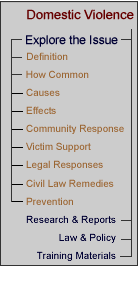|
|
|
8. Civil Law Remedies Throughout the CEE/CIS region, victims of domestic violence turn to civil law remedies, including divorce and orders for protection (OFPs), to escape abuse. In addition, because of the ways in which batterers can use child custody and visitation against their former partners, it is critical that the laws that govern child custody determinations, laws most often invoked during divorce, further the safety of both the child and the non-abusive parent. Divorce is frequently seen as the only option for women fleeing violent husbands. However, it is often extremely difficult for women to obtain a divorce and keep herself safe during the process. Divorces are often costly for women. ď[W]omen bear the costs of feeding and clothing the children (a task made especially difficult given the lack of enforcement mechanisms for child support and alimony payment) and also bear the burden of locating a new home.Ē From MAHR, Domestic Violence in Macedonia 24 (1998). In Moldova, women reported that lack of housing alternatives and severe economic circumstances deter women from seeking divorces. Countries throughout the region are experiencing similar problems. Women in Moldova and Poland also reported that courts may postpone hearings on divorce cases to encourage reconciliation. This approach has extremely dangerous consequences for women since research shows that during the period directly following a womanís decision to leave her abuser, the risk of serious, even lethal, violence increases. From MAHR, Domestic Violence in Poland 39 (2002); MAHR, Domestic Violence in Moldova 34, 35 (2000). Also, in countries where women must show fault to obtain a divorce, details of abuse may become part of the proceedings. In cases where fault is not at issue, judges may nonetheless see signs of abuse during the proceedings but not address it. Domestic violence advocates have recognized the importance of civil law remedies for battered women and in many places, have accomplished significant reform in the areas of family law and divorce. Orders for Protection and No Contact Orders Few countries in the CEE/CIS region have civil remedies designed to protect the victim and temporarily remove the abuser from the home. One civil remedy used in some countries, often called a civil protection order or order for protection (OFP), is an order issued by a judge to exclude an abuser from the home for a period of time to protect a woman and her children. These protection orders can take the form of emergency ex parte orders (temporary orders issued without notice to the defendant), which last a short time. Women may also seek longer term orders for protection. These orders require a full hearing before a judge with the abuser present. Many women use this civil court process instead of using the criminal court system. The international model code includes a civil protection order provision. Civil protection orders were controversial when they came into use in the United States, but there were convincing reasons that they were important for protecting women against domestic violence. While a civil protection order interferes with an abuserís property rights (i.e., the right to live in oneís house), the legislature made a determination that a womanís right to be free from violence is more important than the abuserís property rights. When an abuser was putting other members of the household in danger with his behavior, justice required that he should leave the home, not the women and the children. Advocates should closely monitor the laws and their implementation and educate officials in order for the civil protection to be an adequate remedy. |
| Home | Contact | Feedback | Disclaimer |

